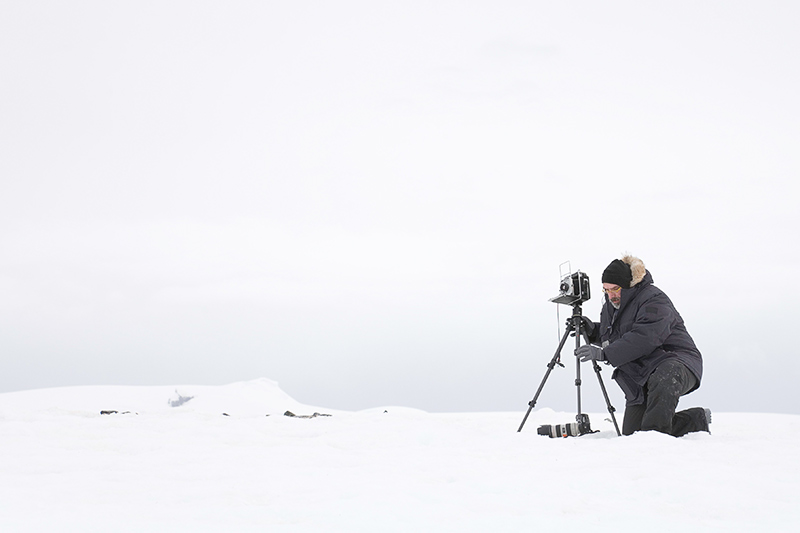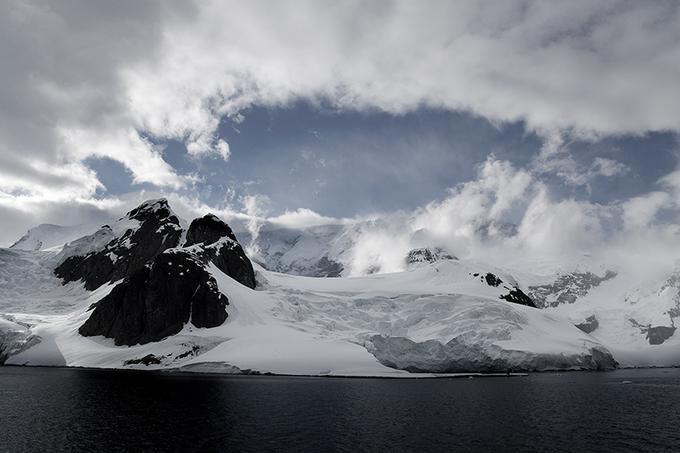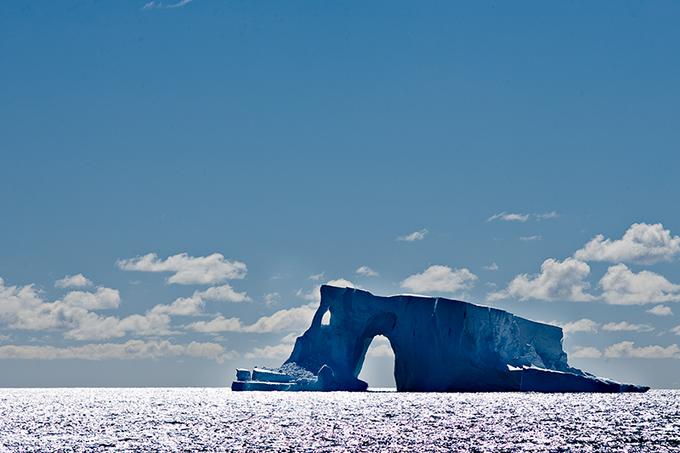From aboard a Russian Icebreaker
Notes from a 4x5 photographer in Antarctica
- Part 2 -
by Brian Pawlowski with an introduction by Alain Briot
Other essays in this series

Photograph Copyright 2005 Stephen L. Starkman
Introduction
Brian is coming to the end of his journey in Antarctica and in this second update, sent from the Akademik Shokalskiy Russian Icebreaker, he lists a number of conclusions about the trip.
Alain Briot
From Aboard a Russian Icebreaker, Part 2
We spotted two, later joined by a third, Humpback Whales during the crossing. As I went on deck to see them, I mused that things might work best with a plan, and to have a camera at ready. I had carefully packed my cameras for the crossing of the Drake Passage in case it got rough. To prevent damage to them as things were flying around (including me). I was not prepared for encountering whales en route back. For the brief period we saw the whales I had little time to open my pack grab my 70-200 lens and set the camera for whale sport photography. I had the shutter set to single shot - missed the moment of the tail fully articulated out of the water that continuous burst mode would've grabbed.
What would I do differently in a future trip to the Antarctic? First and foremost, come up with a plan for shooting. What was I after? What would be my minimum walkaways? I rarely shoot a model or even a still life without a script to start from. The different "scenes" I want to try, the props needed, the feeling being sought. I spent too much time worrying if I my gloves were warm enough (they were, and my Canada Goose Expedition parka and waterproof snow mobile bib kept me if anything too hot). During a talk by John Paul Caponigro where he described his current projects and how he sketched out some conceptual drawings of the types of images he was after I realized I was without a plan. Caponigro's point was to have a plan but allow for flexibility and being open to opportunity and allowing yourself to respond to a place. It would've helped focus my shooting.
On equipment perhaps a 75mm or so lens for the Graflex would've been a nice bring along. I like to shoot wide in landscapes. The 135mm was a bit constraining.
For the full frame digital SLR I regretted not bringing some primes. In retrospect, given the limitation of approach of the ship to coastline, and safe working distance to penguins and other wildlife (to avoid stressing them), a 300mm prime would've been a better choice than the 70-200mm. And something in a 20 wide angle. A short zoom in the middle range (for Canon - I was unable to get my hands on the new 24-105mm L series lens before leaving) might have filled out the kit.
Storage. I shot a lot - perhaps too much. I think I focused down when I put the dSLR on a tripod and chose shots more carefully. But most of the shooting while on the ship is necessarily handheld - things are moving by too fast. I ended up with 50 - 60 GBs of raw images from the Canon 1Ds Mark II. I ruthlessly deleted obvious bad images - but I needed more scratch space to even do the editing. I had 20 GB free on my internal drive on my laptop. And 50 GB free on an external drive. Two completely empty external 100 GB hard drives (one for backup) would've been a better plan.
On planning the shooting for a trip like this. I think Michael Reichmann made a good point today. He doesn't spend time looking at images of places he is going to so as to not influence his impressions of a place before he arrives. I agree with that - I avoided looking at Antarctic picture books before departure.

But I think my best images of the trip arose after a sleepless night spent reading Scott's journals of his last Antarctic Expedition in 1912. He died after reaching the South Pole second (to Amundsen), 11 miles from a supply hut he was blocked from reaching by a raging blizzard. He kept writing up until the end. The journals were found on him nine months later as he sat between two companions, arm outstretched over one. That morning at 5AM I went on deck and started photographing the stark white landscape, black rock cliffs, clouds and blowing snow. A cloud form appeared that seemed to prefigure disaster. Those images I like the most so far from the trip. So reading about a location - classic accounts and diaries - provide perspective and depth to one's visual impressions.
On the other hand, I came to gracefully accept in the end that many of the images would be a travelogue of my Antarctic vacation. So, I tried to do my best on the penguin, seal and landscape shots. Katrin Eismann encouraged me to explore digital panoramic photos by shooting and stitching manual exposed images with about 30% overlap. One aspect of the landscape here is the vast stretches of textured whiteness surrounding you. I have high hopes for creating several panoramas from my raw shots when I get home (to more disk space and compute power) - some rough drafts showed a great deal of promise in communicating the impressions I got as we sailed the Antarctic Peninsula.
I'm staring at a summary of the voyage - 1874 nautical miles. Aitcho Island and Half Moon Island landed on December 3 and 4 following the two day passage in the Drake Crossing. The Lemaire Channel glowed during the long sunset as we pushed our way through the thin sea ice on December 5 following landings in Paradise Bay and our first steps on the Antarctic continent. We reached our southernmost point at midnight in the channel at 65 deg 07'S 64 deg 02'W. December 6 through the Gerlache Strait and more around the peninsula - and the on deck BBQ where the age old problem of how to keep a beer cold was neatly solved - but keeping food warm was a puzzle. Because of poor light conditions we decided to not land at Brown Bluff - though I took some stark images from the deck of the Akademik Shokalskiy. December 8 saw our return to the South Shetland Islands and the warm hiking and polar plunge on Deception Island at Whaler's Bay.

I just gave Valeriy - one of the Russian crew members - pictures printed on board on an Epson Picture Mate Deluxe printer. He wanted images of the craters and caldera of Deception Island. Some of my Antarctic travelogue. I also gave him my Sorel boots which I never wore - note to self: you will wear the expedition provided standard issue rubber boots for the wet landings off the Zodiac - properly disinfected between landings to prevent spreading disease between penguin colonies - so there's no need to bring your own boots.
As I sat here finishing up this e-mail, Phil from Quark Expeditions asked me if I would go again. I replied to my surprise "Yes." I would do some things differently. He suggested I explore the Ross Ice Shelf next. As a one of the other participants in the workshop remarked in the Lemaire Channel as the snow covered mountains blazed "What do you do after this?"
Brian Pawlowski
Introduction Copyright © Alain Briot 2005
Essay Copyright © Brian Pawlowski 2005
All rights reserved worldwide
.